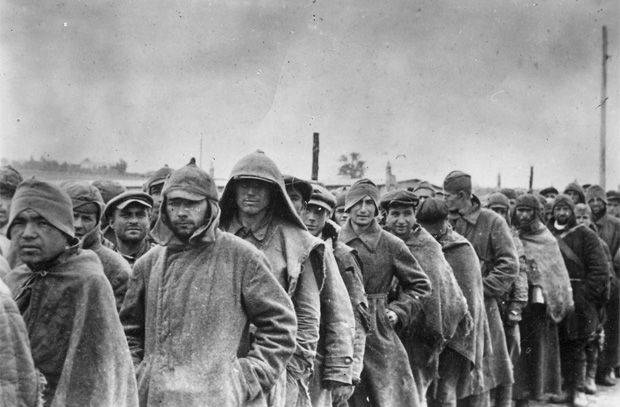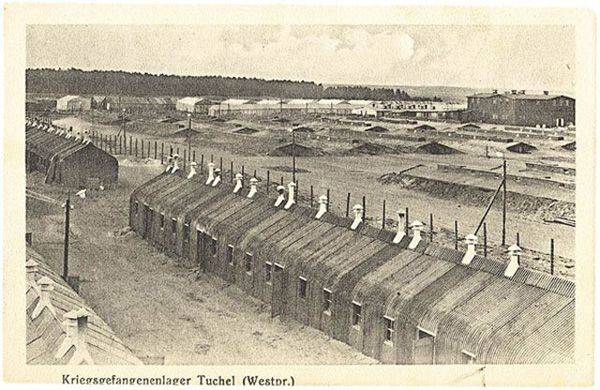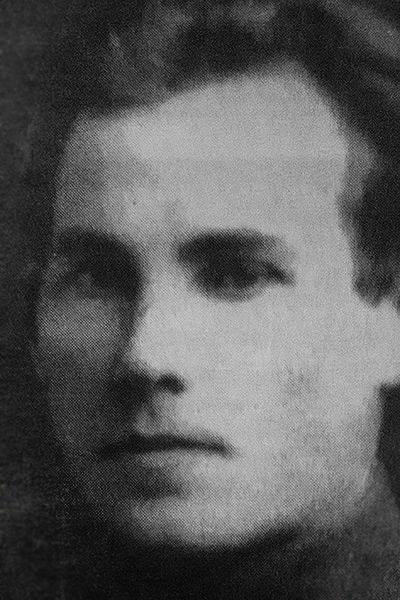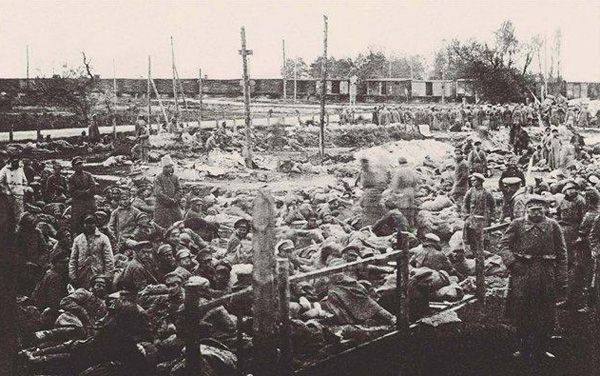Red Army soldiers in Polish captivity

European concentration camp 1919 of the year through the eyes of the commander of the Red Army
The theme of Polish prisoners of war in Katyn pops up in Poland whenever it comes to its relationship with Russia. But to recall the fate of about two hundred thousand Red Army, trapped in the Polish concentration camps, it is not accepted.
New borders of the Commonwealth
It is possible that long-past events could have been left to the court of a narrow circle of historians, if only the shadows of the past did not like to feed on aggressive nationalism. Recently, the Polish radicals are moving from words to action: on Independence Day on November 11, 2013, participants in the nationalist “Independence March” attacked the Russian Embassy in Warsaw. This year, the national holiday is once again celebrated "The Run of Independence". But on the map of the "Polish run" the territory of Western Belarus is already marked as part of the Commonwealth. In the past, 2014, the race winners, were given medals cast in the shape of a map of Poland with a fair amount of Western Belarus and Ukraine.
Almost a hundred years ago, the Polish army had already fought eastward, seizing Belarus. And two decades before Katyn, an even greater tragedy broke out in the camps for Russian prisoners of war. In one of the archives, the author found evidence from the commander of the Red Army, Vasily Selivanov, about his stay in the Polish concentration camp in 1919.
Vasily Stepanovich Selivanov participated in the First World War, the October Revolution met in the ranks of the party of the Left Social Revolutionaries. In December, 1917 was a delegate to the All-Belarusian Congress in Minsk, which was dispersed by order of Oblikomzap chairman Alexander Myasnikov (Myasnikyan). Selivanov, like all the Left Social Revolutionaries, criticized the Bolsheviks for the Brest Peace with Germany and the heavy surplus for the peasants. In July, 1918 was elected a delegate to the 5 Congress of Soviets in Moscow. After the Left Socialist-Revolutionary uprising that broke out at that time, he was arrested by the Cheka. After liberation, he arrived in Gomel occupied by the Germans and Ukrainian Haidamaks. He actively participated in the combat operations of the local underground, blew up the hetman Warta (police) branch in Gomel.
After the liberation of Gomel from the Germans and Haidamaks in January 1919, Vasily Selivanov joined the Communist Party. Obviously, like many other Left Social Revolutionaries, he considered that the Bolsheviks, for all their harshness and ambiguity, were the most effective force in the revolution, including in the struggle against foreign intervention in Russia.
"Smooth with even ..."
Already at the beginning of 1919, Polish legions rush to Belarus. Strictly speaking, the Polish pansy never left this place.
And after the division of the Polish-Lithuanian Commonwealth, most of the Polish landowners remained in Belarus. Some of them participated in three Polish uprisings, some, on the contrary, in their suppression. In the summer of 1917 in Belarus, the Polish Corps of General Jozef Dovbor-Musnitsky was formed as part of the Russian army. Legionnaires were under the ideological influence of Polish nationalists of the most extreme sense - the "people's democracy". Therefore, immediately after the October Revolution, numerous Polish landowners of the Mogilev province saw in the armed legions their natural defense against Belarusian peasants. In January, the 1918 th Polish Corps launched a revolt. But the Red Guard detachments defeated units of Dovbor-Musnitsky near Rogachev and Zhlobin, the Polish legions moved away to the west and, together with the German army, occupied Minsk.
But the German Empire suffered a defeat in the war, and then the Polish patriots, previously loyal to Germany, declared the formation of a new Polish-Lithuanian Commonwealth. At the same time, the "people's democrats" without ceremony said that all Belarusian and Ukrainian lands should enter the borders of Poland of model 1772. But the protégé of the “narodvitsev”, Jozef Dovbor-Musnitsky, removed another Jozef - Pilsudski from power. This renegade of the socialist movement, becoming the “Head of the Polish State”, pursued a more flexible policy: Pilsudski hinted at some kind of “federation” with Belarus and Ukraine. But while Polish politicians were building different combinations, the Polish legions began to seize Belarus. Pilsudski’s demagogic slogan “Free with freedom, even with smooth ...” in fact turned into concentration camps and arrests not only for communists, but also for Belarusian national figures, for looting and pogroms for the peaceful population.

In view of the onset of the Piłsudski legions, the Red Army opened a new front in Belarus, the “Belopolsky” front.
Trotsky against the proletarian battalions
In April – May, the 1919 Revolutionary Proletarian Battalion was formed to assist the Western Front in Gomel in 1. The word “proletarian” is not just a tribute to the spirit of the time: the unit really consisted of workers who joined it voluntarily or on “union mobilization”. The initiator of the creation of the battalion was the young leader of the Trade Union of commercial and industrial employees Azriel Zharkovsky.
True, it was not without incidents during the formation of the battalion. According to strict Marxist canons, some of the members of the Gomel trade unions were not the proletariat at all, but also artisans and other "petty-bourgeois fellow travelers." And some of them, quite according to Demian Poor, believed that the Bolsheviks would do without them. As the newspaper “The Way of the Soviets” wrote 10 in May 1919, a member of the trade union of the garment workers, a certain G. Yudashkin, voted for the trade-union mobilization, but at the same time was released from it “for health reasons”. But the brave Swede refused to undergo a repeat medical examination. Whether he was a distant relative or just the namesake of the famous fashion designer, story is silent.
Vasily Selivanov, a former left SR, was appointed commander of the battalion. It was assumed that the formation will operate under the control of "all parties advocating Soviet power." Perhaps it was this circumstance that caused a negative attitude towards the battalion on the part of Lev Trotsky. In May 1919, the formidable chairman of the Revolutionary Military Council of the Republic issued an order: “Dismantle the 1 th Proletarian battalion, hand over the head of the Pariysky headquarters to the guard battalion, send the personnel to the marching companies ...”
But Trotsky in Gomel did not obey: the marching companies were sent to the front, but the battalion was not disbanded.
"Comrades Red Army, with God!"
After the arrival in Minsk of the three companies of the proletarian battalion, Selivanov was transferred to the commissars, and the former officer Chiber was appointed as the battalion commander. The commander of the 17 Infantry Division Borzinsky, also an officer of the tsarist army, delivered a speech before the new arrivals. Sending the battalion to the front line, the commander Borzinsky addressed the Red Army soldiers in the old way: “God be with you!” Almost immediately after arriving at the positions, the battalion was involved in heavy battles with the Poles. In the first battle in the positions of Blue Gorka two fighters were killed. Selivanova wounded in the arm, but he did not leave the front line. Three days later, at the village of Stayki, a battalion of bayonet counterattack overturned the Polish infantry. The founder of the battalion Zharkovsky was killed. June 30 command, not listening to the objections Selivanova, under the Blue Gorka threw the battalion in an unprepared, without artillery support attack. A third of the personnel was killed, the remnants of the battalion were reduced to one company.

1 July 1919, the Polish army in Belarus, many times reinforced by the 70-thousandth corps of General Józef Haller from France, launched an offensive on the entire front. By the morning of July 3, the “proletarian” company was surrounded by the village of Liski. Selivanov raised it to the counterattack, but fell: his legs were interrupted by a machine-gun burst. Before being taken prisoner, the few Red Army men who had survived from the company hid Selivanov’s leather jacket and shaved his lush head of hair: it was known that the Poles had personal orientations for commanders and commissars.
The bleeding wounded Poles laid out in a row, without rendering them any help. They drove past the rest of the prisoners, demanding to indicate the commanders and political workers. In case of identification Selivanova was waiting for the immediate execution. But no one gave him away, and one of the fighters even said: “Our commander was killed before my eyes.”
Survivors waited concentration camps in Poland.
"Human need, appealing to heaven for retribution ..."
In the crowded goods wagons, the prisoners were taken to the Belostok transit camp. Selivanov wrote: “In the camp, as a rule, there was no bread at all for the prisoners of bread, and there is no need to talk about hot food. In this camp, we had no days of bread at all for 8 – 10 ... We witnessed the prisoners tearing grass from under the barbed wire and eating it.
In addition to starvation, the day after our arrival, the White-Polish gendarmes finally began to undress the prisoners, taking the outer clothing and, if anyone had, decent underwear. In exchange, they gave out dirty rags.
The wounded still did not receive medical care. It happened, comrades died from blood poisoning, and some were bleeding from wounds and were unconscious. In these painful moments, Maria Tkach, who worked at that time in an underground organization, helped the wounded. For days she stood at the wire fence and handed out dressings ... "
However, even in the Polish army there were honest people protesting against this state of affairs. The head of the sanitary department of the Polish Ministry of War wrote: “I visited the camp of prisoners in Bialystok and now I dared to turn to Mr. General as the chief doctor describing that terrible picture that appears to everyone arriving at the camp. Again, the same criminal neglect of the duties of all the organs in the camp brought shame on the Polish army. At every step dirt, untidiness that cannot be described, human need, appealing to heaven for retribution. ”
From Bialystok camp prisoners were transported to Warsaw. When the Red Army was driven through the streets of the Polish capital, the nationalists gathered on the sidewalks beat them with sticks and fists. The guards drove away only the workers who tried to transfer bread to the captives. In Warsaw, for the first time, the prisoners were fed with some kind of unthinkable burda They spent the night at the train station, standing in the pouring rain. Periodically they were approached by the legionnaires Jozef Haller.

- That pan was in the Cheka in Moscow? - the Gallerist said to a randomly chosen victim, and the brutal beating began.
"Mogilev Province, come out before the whipping ..."
From Warsaw, the Red Army soldiers were transported to a camp near the town of Stshalkovo (Schelkovo). It was the largest concentration camp for Russian prisoners of war. Immediately there were interned Petliurists and participants of the Strekopytov revolt in Gomel, in the suppression of which Selivanov participated in the March of 1919. However, the Poles still intended to use them in the war with Soviet Russia and kept them in tolerable conditions, while the Red Army men were placed in separate “Bolshevik” barracks and subjected to cruel harassment.
The commandant of the Stshalkovsky camp was Lieutenant Malinovsky, a Polish landowner from near Baranavichy. For the Belarusian peasants who rebelled against Pan, he had special feelings. The camp guards were armed with whips that constantly floated. For the slightest offense, prisoners were sentenced to flogging. According to the memoirs of Vasily Selivanov, prisoners of war were flogged and just like that, whole gubernias: today they brought out the execution of the natives of Mogilev region, tomorrow - of the Minsk province. Sometimes used and whips made of barbed wire. If the tortured moaned, Malinovsky personally finishes him with a revolver. The life of a prisoner was worth three cigarettes: Malinovsky awarded the sentry who shot the prisoner with precisely this amount of tobacco products.
According to Selivanov, in the Stshalkovsk camp several dozens of people died per day from beatings, hunger and disease. According to the Russian delegation from the mixed Russian-Ukrainian-Polish commission, 10 thousand people, almost every third prisoner, died in Stshalkovo.
But if frank sadists were guarding the Polish concentration camps, then there were also people who risked themselves for the sake of helping prisoners. Polish, French, and English doctors treated the Red Army men, some of them themselves died after contracting typhus. Doctors from the Ukrainian barracks Livshits and Saption saved a lot of “Bolsheviks”. They, along with the rabbi of the town of Strshalkovo under the guise of helping religious Jews supplied all Russian prisoners of war with additional bread.
In October, 1919, Dr. Livshits helped Vasily Selivanov to escape from the camp. The fugitive made his way through the nights, hiding from prying eyes during the day. Barely alive from hunger and fatigue, the former battalion commander crossed the front line on the Ptich River. As soon as he came to himself, Vasily Selivanov returned to the service, and then wrote memoirs ...
****
In total, in captivity in Poland in the 1919 – 1921 years, according to various sources, thousands of Russian prisoners of war were killed. Almost half of the Red Army men who were in Polish concentration camps died or were killed. In captivity, the “bloody Bolsheviks” died only one out of twenty Poles ... Today, Polish officials say that the dead prisoners have become common victims of infectious diseases. But numerous facts, including the above-mentioned evidence, suggest that the Polish administration conducted a selective policy of ill-treatment and the deliberate physical destruction of Red Army soldiers in prisoners of war.
In May, a memorial sign was erected at the site of the death of Russian prisoners of war in Strzalkowo. But very soon he was removed, as "not agreed" with the local authorities. Following the monument to the 2011 – 1919 Red Army soldiers, there was a turn of monuments to soldiers of the Soviet army. In September of this year, a monument to the Soviet commander of the front Ivan Chernyakhovsky who was killed during the liberation of the Polish land was demolished in Penenzhno ...
Information